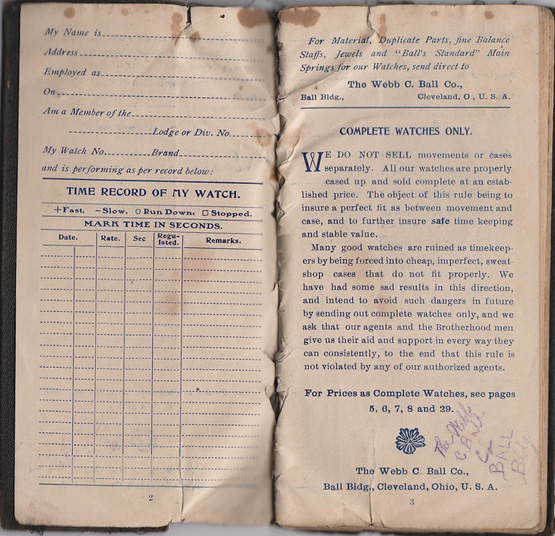
| WWT Shows | CLICK TO: Join and Support Internet Horology Club 185™ | IHC185™ Forums |

|
• Check Out Our... • • TWO Book Offer! • |
Welcome Aboard IHC185™  Internet Horology Club 185
Internet Horology Club 185  IHC185™ Discussion Site Main Page
IHC185™ Discussion Site Main Page  Horological Discussions, Questions and Answers
Horological Discussions, Questions and Answers  Pocket Watch Discussions
Pocket Watch Discussions  Ball Hamilton 18s 17j
Ball Hamilton 18s 17j
 Internet Horology Club 185
Internet Horology Club 185  IHC185™ Discussion Site Main Page
IHC185™ Discussion Site Main Page  Horological Discussions, Questions and Answers
Horological Discussions, Questions and Answers  Pocket Watch Discussions
Pocket Watch Discussions  Ball Hamilton 18s 17j
Ball Hamilton 18s 17jGo  | New Topic  | Find-Or-Search  | Notify  | Tools  | Reply to Post  |  |
I purchased this Ball Hamilton 182 17j about 10 years ago and haven't noticed until now that it is in a B&B Royal case, NOT marked BALL MODEL. I was looking at it due to the two recently up for sale on our site that are in BALL MODEL cases. Should this watch be in a case marked BALL MODEL? Serial number is 458174 which is listed as a 999H from 1905. | |||
|
| IHC Member 1291 |
Not necessarily Greg...... I believe Ball Watch Company started marking their cases "Ball Model" for the 18S by 1906. That is where most knowledgeable collectors draw the "Ball-Model" line on case markings. With very few exceptions I believe it is fair to say that with 16-size Ball-Walthams we should expect to find "Ball-Model" marked cases by about 1902 and with the 18-size Ball-Hamiltons by 1906 production. One more point about the beginnings of specifically marked as "Ball-Model" cases, the 18-size Ball-Elgins which were produced only in 1904 and 1905 are usually found in cases without "Ball-Model" markings which seems to further support the "by 1906" time-frame reference. I think Ball began using cases that conformed to his later "Ball-Model" specifications by as early as 1900 on the 16-size and 1904 on the 18-size but they lacked "Ball-Model" markings. As far back as the mid-1890s Ball-Howards were cased and timed in Jennot & Shiebler cases that had "Webb C. Ball" markings. The Ball Watch Company cased their movements in Cleveland but likely sold some of their 18-size movements in the seller's choice of other cases. Just because their watches were cased and timed in their facility should not be taken to imply that every 18-size movement was sold in a "Ball-Model" case. Since the 18-size "Ball Model" cases were clearly available by 1906 on they will always be preferred for the later movements, I'm sure we all agree that if you have a choice that's the way to go. Since there are far more movements than cases surviving that means the value of these desirable marked cases will continue to escalate. Ball had a "sold complete cased and timed in their facility" policy, this began long before there were marked as "Ball Model" cases, some of the early examples have the very same basic mechanical features as we normally associate with Ball Model cases, but were not marked as such. The easiest way to recognize true Ball cases is by their wide light reflector ring. An ad in the 1902 Ball Catalog states: "Many good watches are ruined as timekeepers by being forced into cheap, imperfect sweat shop cases that do not fit properly. We have had some sad results in this direction, and intend to avoid such dangers in future by sending out complete watches only" We'll never know for sure, but based on Ball's advertising and the evidence of the watches we find, I think it's an entirely reasonable conclusion that Ball was buying cases to their specification before there were marked Ball Model cases. regards, bb Ad Picture 1;  | |||
|
You explained that very well. I guess my concern would be that if I ever do wish to sell it, that people less educated in these than you are would pay less due to the case "issue". | ||||
|
| Site Administrator IHC Life Member |
Buster, very nice explanation, thank you. | |||
|
Thank you for clearing that up for me Buster! | ||||
|
This issue has come up several times before but the answers are buried in various threads. Could one of the moderators retitle this thread "Ball Marked 18sz Cases" and add it to the Ball research Forum? happy hunting | ||||
|
| Powered by Social Strata |
| Your request is being processed... |
|
©2002-2025 Internet Horology Club 185™ - Lindell V. Riddle President - All Rights Reserved Worldwide

